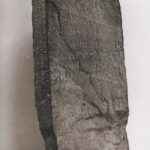The Kensington Runestone is something I am very familiar with. It is in my “neck of the woods”. I remember from an early age that I was aware of this stone. It was something that fascinated me. I could not have been more obsessed. I remember visiting the Runestone Museum. This visit only fueled my interest even more. If you are not familiar with this artifact, I will fill you in.
Olof Ohman discovered this stone in 1898. Olof and his wife Karin owned a farm near Kensington, MN. They were a hard-working family. It was a typical family farm. Olaf and Karin along with their nine children were a very busy family. This was a heavily wooded plot of land. Olof, along with two of his sons were busy clearing trees when the stone was discovered. Edward, whom was ten at the time, noticed the inscriptions.
Validity of The Kensington Runestone
Although I have no doubt of the validity of this stone, some people believe that the stone is a hoax. There certainly has been much debate about it over the years. The debate rotates around some of the linguistic features of the inscription. I have done my research over the years. I have learned that the runes used in the inscription are consistent with those used in medieval Scandinavia. The inscription also includes several Old Norse words and phrases. These particular words and phrases would not have been known to this farmer in 1898.
I believe the Kensington Runestone is legitimate for several reasons. First, as I have already stated he was a very busy farmer. He had six kids ages 1-11. He simply would not have had time to take up such an arduous task. Secondly, there is no way for him to have known the words and phrases used by the Norse at this time. Additionally, the skill necessary to carve the runes into the stone would require much skill. And again, he simply would not have had the time to develop this skill.
I would suggest that if you ever Travel Minnesota, to give this stone a look. It will be a great way to spend quality time together as a family. Gather information along the way and make up your own mind. Your kids will not be bored with this learning experience. It will be very interesting either way. You will learn much about the history of Norse exploration in North America. You might be as surprised as many others are about how much you don’t know about the history of exploration in this country.
The Translation
8 goths and 22 northmen on
discovery trip from
Vinland of west. We
had camp by two skeeries
one day’s journey north from
this stone. We were to fish
one day after we came home found
10 men red with blood and dead. AVM
save from evil have 10 men by the sea to look after our ship 14 day
travel from this island. Year 1362.
The above translation was taken from this site. The carving on the stone contains an inscription of 12 lines using the runic alphabet. Nine lines appear on the face and the last three on a side; information from The Kensington Area Heritage Society. This is an Incredible Resource. The stone is approximately 31” X 15” X 6” in size. It weighs about 200 pounds.
The runic alphabets used letters known as runes. Runes were used to write various Germanic style languages. This was prior to the adoption of the Latin alphabet. This is an interesting study all by itself. Fupark is the Scandinavian variant. This unique word was “invented” using the first six letters of the alphabet. The Latin alphabet eventually replaced the runic alphabet.
Other Runestones of Interest
The Spirit Pond runestones are very interesting. These stones are small handheld objects. There are three of them. One of the stones is a “Map Stone”. The map depicts the landscape visible from the top of White Mountain. At 1,075 feet, it is the highest point in the area around Spirit Pond.
The Alaskan Rune is a stone discovered in the Great State of Alaska. Also known as the Fragment of the Rune Epitaph. This Incredible find is inscribed with a previously undiscovered type of runes. This is a small gray stone with just a portion of a string of runes on the surface of it. Interestingly, it appears that the rune alphabet used on this fragment is unique to Alaskan runes.
I think this is a very interesting topic. Also, so much work has gone into verifying these Incredible finds. Using Carbon Dating technology available today, this is extremely accurate. This dating technology puts to rest the naysayer’s arguments. So, when you are traveling around the world, remember to check out these fascinating stones.


